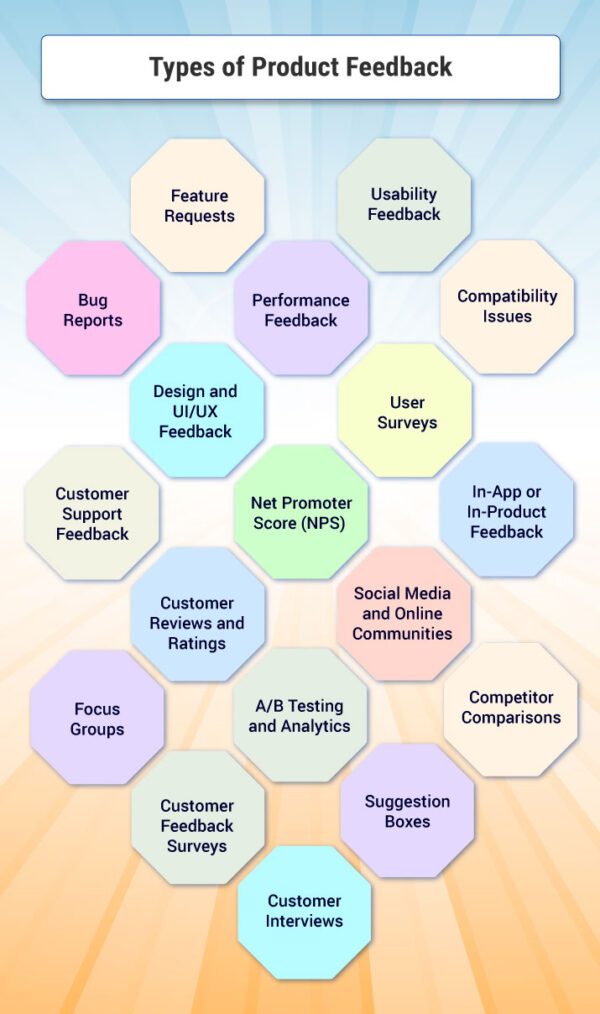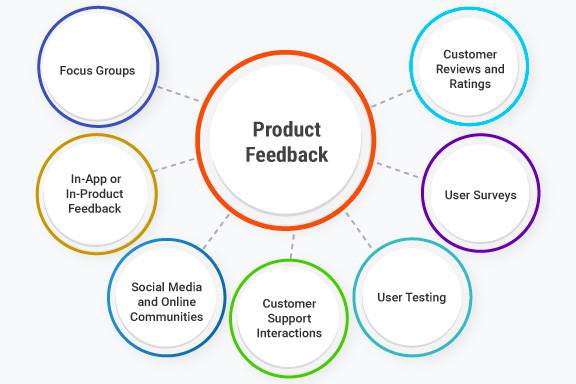Table of Contents
What is Product Feedback?
Product feedback is defined as the information, opinions, and suggestions provided by customers, users, or stakeholders about a particular product or service. It is a crucial component of product development and improvement, as it offers insights into how well a product meets user needs, what areas need enhancement, and what features or functionalities should be added or removed.
Product feedback can take various forms, including:
- Customer Reviews and Ratings: Customers often leave reviews and ratings on websites or app stores, which can provide valuable feedback about their experiences with a product.
- User Surveys: Companies often distribute surveys to collect structured feedback from users. These surveys may cover various aspects of the product, such as usability, performance, design, and overall satisfaction.
- User Testing: This involves observing users as they interact with the product, either in a controlled testing environment or in real-world usage. It helps identify usability issues and user preferences.
- Customer Support Interactions: Feedback can also come from customer support interactions, such as emails, chat logs, or phone calls. These interactions can reveal common problems or areas where users are experiencing difficulties.
- Social Media and Online Communities: Customers frequently share their thoughts and experiences on social media platforms, forums, and community websites. Monitoring these channels can provide insights into user sentiment and issues.
- In-App or In-Product Feedback: Many products incorporate feedback mechanisms within the application or service, allowing users to report issues, suggest improvements, or provide comments directly.
- Focus Groups: Companies may organize focus groups to gather detailed feedback from a select group of users. These sessions are often moderated to delve deeper into user opinions.
The goal of collecting and analyzing product feedback is to make informed decisions about product development and updates. By listening to user feedback, companies can prioritize features, fix bugs, and iterate on their products to align them more closely with user needs and preferences. This iterative feedback loop is a fundamental part of agile product development and customer-centric design.
Types of Product Feedback

Product feedback comes in various types, each providing different insights into how users perceive and interact with a product. Understanding these types of feedback can help businesses and product developers gain valuable insights and improve their offerings. Here are some common types of product feedback:
- Feature Requests: Users suggest new features or functionalities they would like to see in the product. These requests can help prioritize development efforts.
- Bug Reports: Users report technical issues, glitches, or errors they encounter while using the product. Bug reports are essential for identifying and fixing problems.
- Usability Feedback: Users provide feedback on the overall user experience, including issues related to navigation, interface design, and ease of use.
- Performance Feedback: Users comment on the product’s speed, responsiveness, and overall performance. This type of feedback helps address performance-related issues.
- Design and UI/UX Feedback: Users offer opinions on the visual design, user interface (UI), and user experience (UX) of the product. This feedback can lead to improvements in aesthetics and user-friendliness.
- Customer Support Feedback: Users share their experiences with customer support interactions, whether positive or negative. This feedback helps evaluate the effectiveness of support services.
- Compatibility Issues: Users highlight problems related to the product’s compatibility with different devices, browsers, or operating systems.
- User Surveys: Companies distribute structured surveys to collect specific feedback on various aspects of the product, such as user satisfaction, usage patterns, and demographics.
- Net Promoter Score (NPS): NPS surveys measure customer loyalty and satisfaction by asking users to rate their likelihood of recommending the product to others. It categorizes users as promoters, passives, or detractors.
- Customer Reviews and Ratings: Users leave reviews and ratings on platforms like app stores, e-commerce websites, or review websites, sharing their opinions and experiences.
- Focus Groups: Companies gather a small group of users for in-depth discussions and feedback sessions. This qualitative feedback provides deeper insights into user preferences and needs.
- In-App or In-Product Feedback: Products often include built-in mechanisms for users to provide feedback directly within the application or service. This can include feedback forms, rating prompts, or comment sections.
- Social Media and Online Communities: Users discuss the product on social media platforms, forums, and community websites. Monitoring these channels can reveal user sentiment and emerging trends.
- A/B Testing and Analytics: Data-driven feedback comes from analytics tools and A/B testing results. It helps assess user behavior and preferences based on user interactions and engagement metrics.
- Competitor Comparisons: Users may compare your product to competitors and provide feedback on how your product stacks up in terms of features, pricing, and overall value.
- Customer Feedback Surveys: These surveys focus on gathering feedback from customers about their overall experience with a company, which may include interactions with multiple products or services.
- Suggestion Boxes: Some companies still use physical or digital suggestion boxes where users can submit feedback or suggestions anonymously.
- Customer Interviews: In-depth interviews with customers provide qualitative insights into their experiences, pain points, and needs related to the product.
Each type of product feedback offers a unique perspective on the product’s strengths and weaknesses. Effective feedback collection and analysis involve considering all these types to make informed decisions for product improvement and development.
Learn more: What is Customer Feedback?
Top 15 Importance of Product Feedback
Product feedback is of paramount importance in the world of business and product development. It serves as a vital source of information and insights that can have a profound impact on the success and evolution of a product. Here are some key reasons highlighting the importance of product feedback:
1. User-Centric Improvement
User feedback puts the needs and preferences of your customers front and center. It helps you develop products that align with user expectations and solve their problems. Adopting a customer-focused approach enhances both customer satisfaction and loyalty.
2. Enhanced User Experience
Feedback enables you to identify and address issues related to usability, design, performance, and functionality. By making improvements based on user suggestions, you create a more enjoyable and efficient user experience.
3. Bug Detection and Resolution
Users often uncover technical glitches and bugs that might not be immediately apparent during development. Promptly addressing these issues helps maintain the product’s reliability and stability.
4. Prioritization of Features
Feature requests and user suggestions help you prioritize your development efforts. By focusing on the features that matter most to your user base, you can allocate resources more effectively and deliver greater value.
5. Competitive Advantage
Understanding how your product compares to competitors in the eyes of users is essential. Feedback can reveal areas where your product excels and where it needs improvement, helping you maintain a competitive edge.
6. Customer Retention
By actively seeking and addressing user feedback, you demonstrate your commitment to providing a better product. This, in turn, can reduce churn rates and increase customer retention.
7. Innovation and Growth
Some of the most innovative ideas for product enhancements and new features come from user feedback. Users often have unique insights and creative suggestions that can drive innovation and growth.
8. Data-Driven Decision-Making
Feedback provides quantifiable data and qualitative insights that can guide decision-making. It allows you to make informed choices about product direction, marketing strategies, and resource allocation.
9. Increased Customer Loyalty
When users see that their feedback is taken seriously and results in tangible improvements, it fosters trust and loyalty. Happy customers are more likely to become advocates for your brand.
10. Early Problem Identification
Feedback allows you to identify and address issues early in the product lifecycle, preventing them from becoming major problems that could lead to customer dissatisfaction or negative reviews.
11. User Engagement
Engaging users through feedback mechanisms can lead to a sense of community and involvement. Users feel valued when they have a say in the product’s development.
12. Product-Market Fit
Continuously collecting and analyzing feedback helps ensure that your product remains aligned with market needs. It allows you to adapt and evolve your product to maintain relevance.
13. Iterative Development
Feedback supports an iterative development process, where you release updates, gather feedback, and iterate again. This agile approach allows you to respond to changing market conditions and user demands.
14. Measuring Customer Satisfaction
Metrics like Net Promoter Score (NPS) and customer satisfaction surveys are valuable indicators of how well your product is meeting user expectations.
15. Market Research
Beyond just improving your current product, feedback can inform your future product development efforts and market strategies. It can provide insights into emerging trends and unmet needs.
Product feedback is a cornerstone of successful product development and business growth. It helps you create products that users love, retain customers, stay competitive, and innovate to meet evolving market demands. Ignoring or neglecting user feedback can result in missed opportunities and dissatisfied customers, which can ultimately impact your bottom line and reputation.
Learn more: What is Customer Feedback Analysis?
Product Feedback Questions
Understanding the significance of well-crafted feedback queries can elevate your product development process to new heights. Before diving into the specifics of crafting product feedback questions, let’s first explore why they are indispensable to your product development journey.
The Importance of Product Feedback Questions:
- Insightful Feedback: Product feedback questions provide a structured framework for collecting insights from users, enabling you to pinpoint strengths, weaknesses, and areas for improvement.
- Data-Driven Decisions: By soliciting feedback through targeted questions, you empower your team to make data-driven decisions informed by user preferences, behaviors, and pain points.
- Continuous Improvement: A continuous feedback loop fosters iterative improvements, ensuring that your product evolves in tandem with user needs and market dynamics.
Crafting Effective Product Feedback Questions:
Now that we’ve established the importance of product feedback questions, let’s delve into the art of crafting them. Consider these essential guidelines:
1. Be Specific and Actionable: Frame questions that elicit specific, actionable responses. Avoid vague inquiries and focus on gathering insights that can drive tangible improvements.
2. Balance Open-Ended and Closed-Ended Questions: Strike a balance between open-ended questions, which encourage detailed responses, and closed-ended questions, which facilitate quantitative analysis.
3. Cover Key Aspects of the User Experience: Design questions that cover all facets of the user experience, including usability, functionality, performance, and overall satisfaction.
4. Prioritize User-Centricity: Tailor questions to resonate with your target audience, taking into account their preferences, behaviors, and pain points. Communicate in a way that resonates with them and acknowledges their issues.
5. Keep it Concise: Respect users’ time by keeping your feedback questions concise and focused. Avoid overwhelming respondents with lengthy surveys or redundant inquiries.
Sample Product Feedback Questions:
To illustrate these principles in action, here are some sample product feedback questions you could incorporate into your feedback collection process:
- On a scale of 1 to 10, how would you rate your satisfaction with the overall user experience of our product?
- What features do you find most valuable/useful in our product, and why?
- Do you encounter any features or functionalities that are unclear or challenging to navigate? If so, please elaborate.
- How would you rate the performance and reliability of our product?
- Have you experienced any glitches or technical difficulties while utilizing our product? If yes, please describe.
- In comparison to similar products you’ve utilized previously, how does our product fare?
- What improvements or enhancements would you like to see in future versions of our product?
- How likely are you to recommend our product to others, and why?
- How responsive and helpful have you found our customer support team in addressing your queries or issues?
- Overall, how satisfied are you with your experience using our product?
Product feedback questions serve as invaluable tools for capturing user insights, driving product innovation, and fostering customer-centricity. By adhering to the principles of effective question crafting and prioritizing user feedback, you can unlock the full potential of your product and propel it toward success in the marketplace. Embrace the power of feedback, and watch your product thrive in the hands of satisfied users.
Most Recent Blogs
Explore the latest innovation insights and trends with our recent blog posts.










